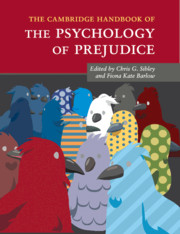Book contents
- Frontmatter
- Dedication
- Contents
- List of Figures
- List of Tables
- Notes on the Contributors
- Part I General Theoretical Perspectives
- 1 An Introduction to the Psychology of Prejudice
- 2 Evolutionary Approaches to Stereotyping and Prejudice
- 3 From Prejudice to Social Change: A Social Identity Perspective
- 4 Ingroup Projection as a Challenge of Diversity: Consensus about and Complexity of Superordinate Categories
- 5 Intergroup Discrimination: Ingroup Love or Outgroup Hate?
- 6 Intergroup Emotions Theory: Prejudice and Differentiated Emotional Reactions toward Outgroups
- 7 Intergroup Threats
- 8 Social Dominance Theory: Explorations in the Psychology of Oppression
- 9 The Dual Process Motivational Model of Ideology and Prejudice
- 10 Is Prejudice Heritable? Evidence from Twin Studies
- Part II Prejudice in Specific Domains
- Part III Prejudice Reduction and Analysis in Applied Contexts
- Index
- References
9 - The Dual Process Motivational Model of Ideology and Prejudice
from Part I - General Theoretical Perspectives
Published online by Cambridge University Press: 17 November 2016
- Frontmatter
- Dedication
- Contents
- List of Figures
- List of Tables
- Notes on the Contributors
- Part I General Theoretical Perspectives
- 1 An Introduction to the Psychology of Prejudice
- 2 Evolutionary Approaches to Stereotyping and Prejudice
- 3 From Prejudice to Social Change: A Social Identity Perspective
- 4 Ingroup Projection as a Challenge of Diversity: Consensus about and Complexity of Superordinate Categories
- 5 Intergroup Discrimination: Ingroup Love or Outgroup Hate?
- 6 Intergroup Emotions Theory: Prejudice and Differentiated Emotional Reactions toward Outgroups
- 7 Intergroup Threats
- 8 Social Dominance Theory: Explorations in the Psychology of Oppression
- 9 The Dual Process Motivational Model of Ideology and Prejudice
- 10 Is Prejudice Heritable? Evidence from Twin Studies
- Part II Prejudice in Specific Domains
- Part III Prejudice Reduction and Analysis in Applied Contexts
- Index
- References
Summary
Early research on prejudice resulted in two important empirical observations. First, the kinds of social groups or categories that are targeted with prejudice vary markedly in different societies; and second, individuals within societies vary markedly in the degree to which they are generally prejudiced or generally tolerant. This suggested that we need two kinds of theories to explain prejudice. In the first case, societal or intergroup theories have focused on particular kinds of intergroup relations (e.g., intergroup competition, threat, or inequality) that would cause prejudice to be directed against specific groups and to be widely shared within a particular society. Thomas Pettigrew (1958) referred to this as the “specificity of prejudice.” In the second case, individual difference theories have focused on certain stable characteristics of individuals (e.g., personality, values, motives, or ideological beliefs) that could cause them to be generally more or less prejudiced against all or most target groups. Early theorists referred to this as the “generality of prejudice” or “generalized prejudice” (e.g., Allport, 1954).
More recently, however, theories have emerged that can encompass both individual and intergroup factors within their explanatory frameworks. The dual process model (DPM) is one such approach. It was originally formulated to explain systematic individual differences in generalized prejudice, which it did in terms of two basic motivational orientations that dispose individuals to be generally prejudiced or tolerant. It also, however, proposed that these two motivational orientations would be largely activated by socially shared situational and intergroup factors (such as intergroup competition, threat, and inequality). In this way both individual and social or intergroup factors would operate together to generate prejudices. These prejudices are both specific (widely shared and directed against targets specific to a particular society) and generalized (with individuals in these societies varying systematically in the degree to which they were generally prejudiced or tolerant).
The DPM encompasses three closely intertwined explanatory contributions to the understanding of prejudice. First, it conceptualizes the two major social attitudinal predictors of individual differences in prejudice as expressions of two distinct motivational goal or value dimensions. Second, the DPM shows how these two motivationally based ideological dimensions are shaped by and emerge from different social and psychological bases. And third, the DPM provides an explanation of why these two motivationally based dimensions cause prejudice and describes how they operate in a complementary and interactive fashion with social and intergroup causes of prejudice.
- Type
- Chapter
- Information
- The Cambridge Handbook of the Psychology of Prejudice , pp. 188 - 221Publisher: Cambridge University PressPrint publication year: 2016
References
- 58
- Cited by



